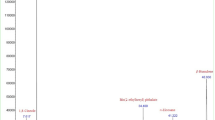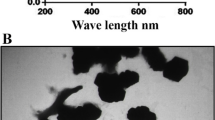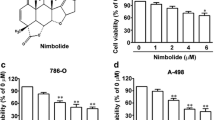Abstract
Biological formulation of copper nanoparticles (Cu-Nps) in cancer treatment has augmented due to its beneficial and curative effects. Ziziphus zizyphus (ZZ) is a species of medicinal plant traditionally used for various ailments. Hence, this work deals with formulation of copper nanoparticles (Cu-NP’s) from Z. zizyphus leaf extracts (Cu-ZZ NP’s) and examine its effect on human renal carcinoma A498 cells. The characterization of the formulated Cu-ZZ NPs was done by spectroscopic and microscopic methods. The anti-cancer tests (MTT, ROS, MMP, Hoechst staining, comet, Real‐time PCR, and western blot) were used to evaluate the biological properties of Cu-ZZ NPs on the growth and proliferation of A498 cells. The cytotoxic activity of Cu-ZZ NPs resulted in potent toxicity of A498 cells. Further, Cu-ZZ NP’s triggered an intracellular ROS generation through mitochondrial pathways in the A498 cells, revealing a noteworthy cytotoxicity activity. Also, fluorescent microscopic studies using Hoechst staining, and comet analysis confirmed the occurrence of apoptosis in Cu-ZZ NPs treated A498 cells. Following, quantitative RT-PCR presented a negative regulation of Bcl-2 expression and positive regulation of Bid, Bax, and caspases (3 and 9) gene expression in Cu-ZZ NP’s treated A498 cells. To further justify, inhibition of mTOR/PI3K/AKT protein expression by Cu-ZZ NPs in A498 cells, lead to an inference that Cu-ZZ NPs induce apoptosis in A498 cells by inhibiting the mTOR, PI3K/Akt pathway.










Similar content being viewed by others
References
Afzal H, Oves M, Alajmi MF, Iqbal H, Samira A, Jahangeer A, Tabish MR, El-Seedi HR, Imran A (2019) Biogenesis of ZnO nanoparticles using Pandanus odorifer leaf extract: anticancer and antimicrobial activities. RSC Adv 9:1535–1567
Ahmed S, Ahmad M, Swami BL, Ikram S (2016) A review on plants extract mediated synthesis of silver nanoparticles for antimicrobial applications: a green expertise. J Adv Res. 7:17–28
Dabestani S, Marconi L, Hofmann F, Stewart F, Lam TB (2014) Local treatments for metastases of renal cell carcinoma: a systematic review. Lancet Oncol 15:e549–e561
Davies MA, Stemke-Hale K, Lin E, Tellez C, Deng W, Gopal YN, Woodman SE, Calderone TC, Ju Z, Lazar AJ (2010) Integrated molecular and clinical analysis of AKT activation in metastatic melanoma. Clin Cancer Res 15:7538–7546
Du TA (2013) Cell death: balance through a bivalent regulator. Nat Rev Mol Cell Biol 14:546
Fantini M, Benvenuto M, Masuelli L, Frajese GV, Tresoldi I, Modesti A (2015) in-vitro and in vivo antitumoral effects of combinations of polyphenols, or polyphenols and anticancer drugs: perspectives on cancer treatment. Int J Mol Sci 16(5):9236–9282
Garamvolgyi R, Dobos J, Sipos A, Boros S, Illyes E, Baska F, Kekesi L, Szabadkai I, Szantai-Kis C, Keri G, Orfi L (2016) Design and synthesis of new imidazo[1,2-a]pyridine and imidazo[1,2-a]pyrazine derivatives with antiproliferative activity against melanoma cells. Eur J Med Chem 108:623–643
Garg AD, Nowis D, Golab J, Vandenabeele P, Krysko DV, Agostinis P (2010) Immunogenic cell death, DAMPs and anticancer therapeutics: an emerging amalgamation. Biochim Biophys Acta 1805:53–71
Gopinath M, Subbaiya R, Selvam MM, Suresh D (2014) Synthesis ofcopper nanoparticles from Nerium oleander leaf aqueous extract andits antibacterial activity. Int J Curr Microbiol Appl Sci 3:814–818
Hizal M, Sendur MAN, Bilgin B, Akinci MB, Dede DS, Yalcin B (2020) A historical turning point for the treatment of advanced renal cell carcinoma: inhibition of immune checkpoint. Curr Med Res Opin 36(4):625–635
Jayandran M, Haneefa MM, Balasubramanian V (2015) Greensynthesis of copper nanoparticles using natural reducer andstabilizer and an evaluation of antimicrobial activity. J ChemPharm Res 7(2):251–259
Jian H, Kefeng Z, Bin Z, Gutian Z, Xiaogong L, Hongqian G, Weidong G, Zhengyang Z, Tian L (2015) Dynamic contrast-enhanced CT characterization of Xp112 translocation/TFE3 gene fusions versus papillary renal cell carcinomas. Biomed Res Int 8:298679
Lin C, Chen P, Hsu L, Kuo DY, Chu S, Hsieh Y (2014) Inhibition of the invasion and migration of renal carcinoma 786-o-si3 cells in vitro and in vivo by Koelreuteria formosana extract. Mol Med Rep 10:3334–3342
Liu H, Li G, Zhang B, Sun D, Wu J, Chen F, Kong F, Luan Y, Jiang W, Wang R, Xue X (2018) Suppression of the NF–κB signaling pathway in colon cancer cells by the natural compound Riccardin D from Dumortierahirsute. Mol med Rep 17(4):5837–5843
Mariani F, Sena P, Roncucci L (2014) Inflammatory pathways in the early steps of colorectal cancer development. World J Gastroenterol 20(29):9716–9731
Nithya K, Kalyanasundharam S (2019) Effect of chemically synthesis compared to biosynthesized ZnO nanoparticles using aqueous extract of C halicacabum and their antibacterial activity. Opennano 4:10024
Pei J, Fu B, Jiang L, Sun T (2019) Biosynthesis, characterization, and anticancer effect of plant-mediated silver nanoparticles using Coptis chinensis. Int J Nanomed 14:1969–1978
Poyil P, Girija K (2011) Oleanolic acid induces apoptosis by modulating p53, BAX, Bcl-2, and caspase-3 gene expression, and regulates the activation of transcription factors and cytokine profile in B16F-10 Melanoma Cells. J Environ Pathol Toxicol Oncol 30(1):21–31
Rashid AO, Ahmed RH, Hassan HA, Bayz AH (2020) Metastasis of renal cell carcinoma to the vocal cord ten years after radical nephrectomy: a case report. Urol Case Rep 28:101059
Tahergorabi Z, Abedini MR, Mitra M, Fard MH, Beydokhti H (2015) “Ziziphus jujuba”: a red fruit with promising anticancer activities. Pharmacognosy reviews 9:99–106
Trachootham D, Alexandre J, Huang P (2009) Targeting cancer cells by ROS-mediated mechanisms: a radical therapeutic approach? Nat Rev Drug Discov 8(7):579–591
Vaux DL (2014) Cell death and cancer. Cell Death 1:121–134
Vijayaraghavan K, Nalini SK, Prakash NU, Madhankumar D (2012) Biomimetic synthesis of silver nanoparticles by aqueous extract of Syzygium aromaticum. Mater Lett 75:33–35
Wang GW, Lv C, Shi ZR, Zeng RT, Dong XY, Zhang WD (2014) Abieslactone induces cell cycle arrest and apoptosis in human hepatocellular carcinomas through the mitochondrial pathway and the generation of reactive oxygen species. PLoS ONE 9(12):e115151
Wu H, Han R, Zhang Q, Zhao Y, Feng H (2020) Metatarsal metastasis from clear cell renal cell carcinoma: a case report and literature review. BMC Urol 20:19
Xue Z, Dong L, Shuhua N, Liwen R (2018) Anticancer action of lactucopicrin in SKMEL-5 human skin cancer cells is mediated via apoptosis induction, G2/M cell cycle arrest and downregulation of m-TOR/PI3K/AKT signalling pathway. JBUON 23(1):224–228
Yang DC, Chen CH (2020) Potential mew therapeutic approaches for renal cell carcinoma. Semin Nephrol 40(1):86–97
Yi H, Ur Rehman F, Zhao C, Liu B, He N (2016) Recent advances in nano scaffolds for bone repair. Bone Res 4:16050
Znaor A, Lortet-Tieulent J, Laversanne M et al (2015) International variations and trends in renal cell carcinoma incidence and mortality. Eur Urol 67:519–530
Author information
Authors and Affiliations
Corresponding author
Ethics declarations
Conflict of interest
We declare that no Conflict of interest.
Additional information
Publisher's Note
Springer Nature remains neutral with regard to jurisdictional claims in published maps and institutional affiliations.
Rights and permissions
About this article
Cite this article
Li, X., Tang, G., Guo, X. et al. Characterization and apoptotic effect of copper nanoparticles biosynthesized from Ziziphus zizyphus leaf on human renal cell carcinoma A498 cells. Appl Nanosci 11, 139–148 (2021). https://doi.org/10.1007/s13204-020-01570-0
Received:
Accepted:
Published:
Issue Date:
DOI: https://doi.org/10.1007/s13204-020-01570-0




